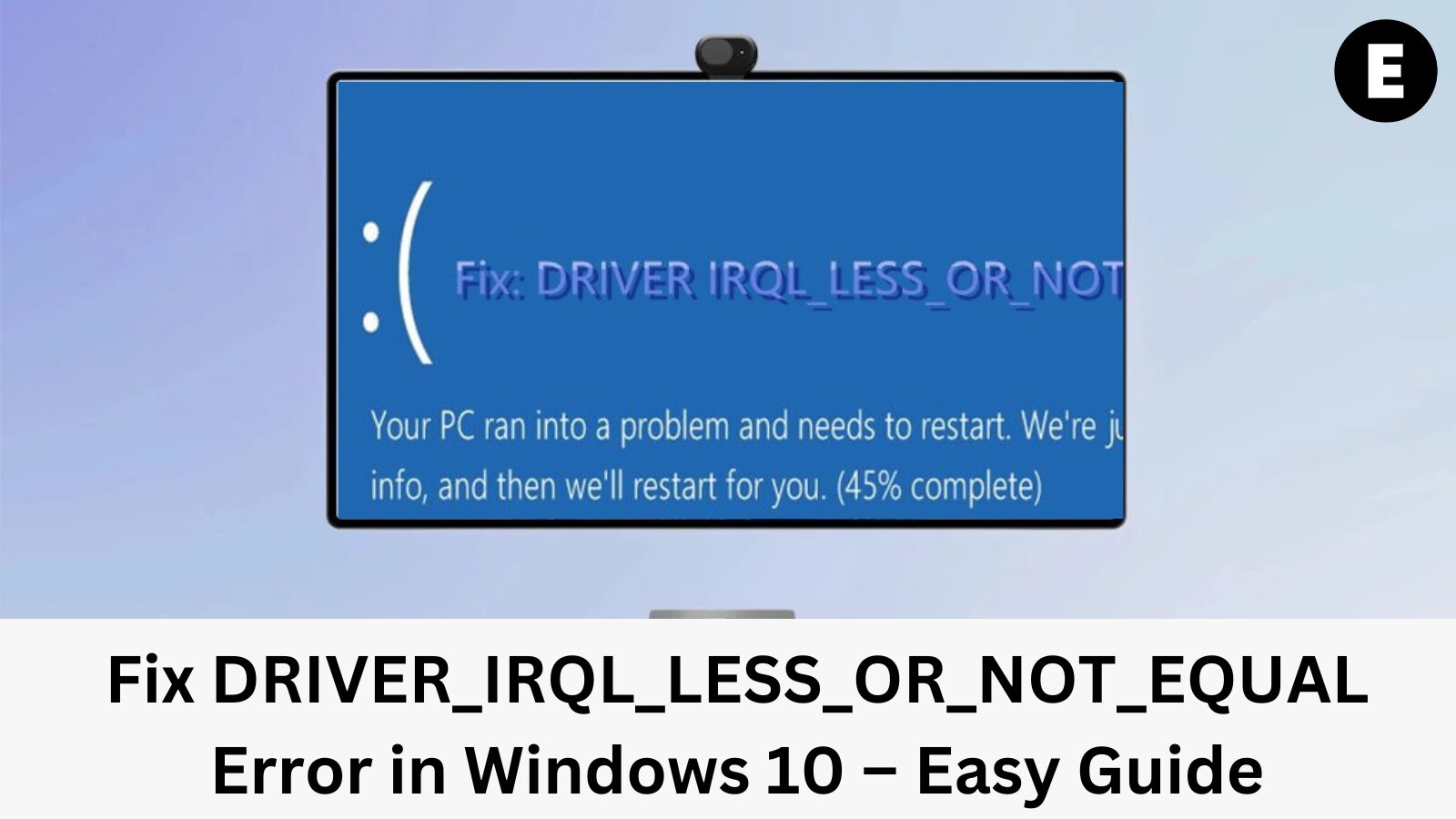Windows 10 is a powerful operating system, but it’s not without issues. One of the most frustrating errors users encounter is the DRIVER_IRQL_LESS_OR_NOT_EQUAL error. This Blue Screen of Death (BSOD) error typically appears when Windows 10 fails to locate a required driver or software during bootup, causing your system to crash.
The DRIVER_IRQL_LESS_OR_NOT_EQUAL BSOD error can occur due to various reasons, such as driver conflicts, corrupt system files, or faulty hardware. If you’re facing this issue, don’t panic—there are several effective troubleshooting steps you can take to resolve it.
In this guide, we’ll walk you through the best solutions to fix the DRIVER_IRQL_LESS_OR_NOT_EQUAL error in Windows 10. Follow these steps to eliminate the BSOD error and restore your system’s stability!
What is the DRIVER_IRQL_LESS_OR_NOT_EQUAL Error in Windows 10?
When your Windows 10 system encounters a fatal error, it triggers a Blue Screen of Death (BSOD), displaying a STOP code before forcing a reboot. This can be frustrating, as it often occurs unexpectedly, leading to lost work and potential file corruption. To minimize the risk, make sure to save your work frequently.
Most BSOD errors in Windows 10 are caused by system-related issues that send a STOP code, resulting in an immediate crash. One commonly reported driver-related blue screen error is the DRIVER_IRQL_LESS_OR_NOT_EQUAL error, also known as a stop code error.
Fortunately, there are several proven solutions to fix this issue and restore your Windows 10 system to normal. In this guide, we’ll explore the best ways to troubleshoot and resolve this error effectively.
What Causes the DRIVER_IRQL_LESS_OR_NOT_EQUAL Error?
At first glance, the DRIVER_IRQL_LESS_OR_NOT_EQUAL error might seem unclear, even to experienced users. Seeing this STOP code during Windows 10 bootup can be frustrating, but understanding the cause is the first step toward fixing it.
This BSOD error typically occurs due to driver conflicts on your system. A device driver may be malfunctioning, clashing with a program, or not communicating properly with the Windows 10 operating system, leading to system instability and crashes.
To resolve this issue, follow the troubleshooting steps outlined below. These methods will help identify and fix the underlying problem, allowing you to restore your system and prevent future crashes.
Solved: DRIVER_IRQL_LESS_OR_NOT_EQUAL Error in Windows 10
It’s crucial to address the DRIVER_IRQL_LESS_OR_NOT_EQUAL error in Windows 10 quickly, as it’s likely to continue affecting your system until resolved. To help you fix this issue, we’ve compiled seven proven solutions that will get your computer back on track swiftly.
Method 1: Update Your BIOS
An outdated BIOS can often cause issues like the DRIVER_IRQL_LESS_OR_NOT_EQUAL error. Updating your BIOS can improve system performance and resolve stability issues tied to older BIOS versions.
Here’s how to update your BIOS:
- Press the Windows + R keys to open the Run utility.
- Type “cmd” (without quotes) and press Enter to open the Command Prompt.
- Type the following commands, pressing Enter after each line:
systeminfo | findstr /I /c:bioswmic bios get manufacturer, smbiosbiosversion
These commands will help identify your BIOS version.
- Next, visit your BIOS manufacturer’s website and follow their instructions to update your BIOS to the latest version.
Warning: Updating your PC BIOS is a delicate process that carries risks. An incorrect update can make your system unbootable. Always back up your system before proceeding, or consult a professional to handle the update safely.
Method 2: Stop Overclocking
Overclocking your GPU can provide a performance boost, pushing your graphics card beyond its factory-set limits. However, it’s important to understand that while overclocking can improve performance, it also carries risks that can negatively impact your computer.
When you overclock your GPU, you’re altering its settings, which may lead to instability. This can cause issues like your graphics card malfunctioning or triggering errors, such as the DRIVER_IRQL_LESS_OR_EQUAL blue screen error.
If you’re experiencing this error, overclocking might be the culprit. While there’s no direct connection between overclocking and this error, many users have successfully resolved the BSOD issue by disabling their overclocking settings. It’s worth trying this solution to see if it eliminates the error and stabilizes your system.
Method 3: Update or Disable Your VPN
A VPN (Virtual Private Network) creates an encrypted tunnel between your device and a server, allowing for anonymous browsing and enhanced privacy online. While VPNs are great for protecting your internet security, they can sometimes cause issues like the DRIVER_IRQL_LESS_OR_NOT_EQUAL error in Windows 10.
If you’re using a VPN, try updating it to the latest version to see if that resolves the BSOD issue. If updating doesn’t help, the next step is to disable the VPN temporarily and check if the error persists.
If your system runs smoothly after disabling the VPN, it’s possible that the VPN was causing the blue screen error. In this case, you may want to consider switching to a different VPN to avoid further issues.
Method 4: Temporarily Disable Your Antivirus
While antivirus software is essential for protecting your system from online threats, it can sometimes interfere with drivers and cause errors like the DRIVER_IRQL_LESS_OR_NOT_EQUAL BSOD in Windows 10. If you’re experiencing this issue, you may need to temporarily disable your antivirus to check if it’s the cause.
Here’s how to do it:
- Right-click on an empty space in your taskbar and select Task Manager from the context menu.
- Switch to the Start-up tab at the top of the Task Manager window.
- Locate your antivirus application in the list, then click on it to select it.
- Click on the Disable button at the bottom-right of the window to prevent the antivirus from starting with your system.
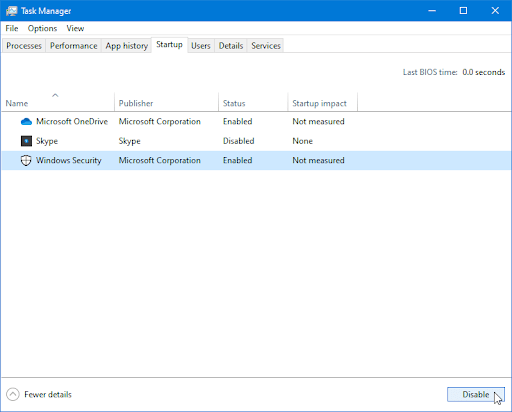
After disabling the antivirus, restart your computer and see if the issue persists. If the system works fine after disabling it, you may need to either update or replace your antivirus software. Just remember to turn it back on after testing or consider finding a new antivirus program if it was causing the problem.
Method 5: Turn Off the Windows Firewall
Disabling the Windows Firewall can sometimes resolve the DRIVER_IRQL_LESS_OR_NOT_EQUAL error in Windows 10. Here’s how you can do it:
- Press the Windows + R keys on your keyboard to open the Run utility.
- Type “firewall.cpl” (without quotes) and click OK.
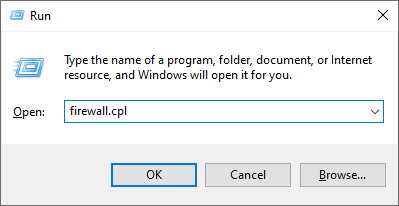
- In the Windows Firewall window, click on the Turn Windows Defender Firewall on or off link on the left side.
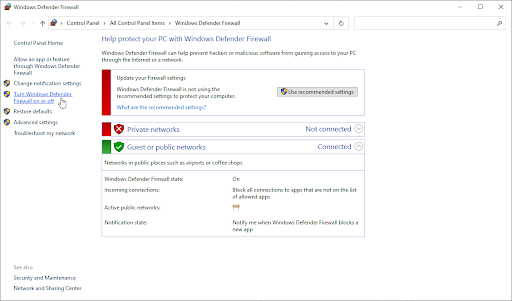
- Under both Private network settings and Public network settings, select the option to Turn off Windows Firewall.
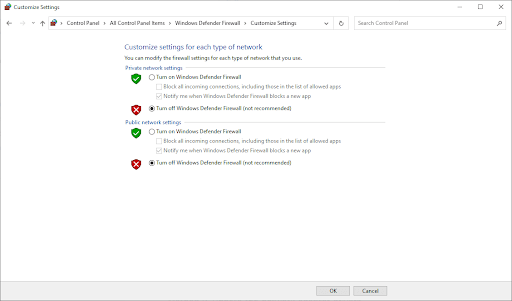
- Click OK and restart your computer.
After restarting, check if the BSOD error persists. If turning off the firewall resolves the issue, you may want to consider re-enabling it later or configuring the firewall settings to prevent conflicts.
Method 6: Make Sure Your Drivers Are Up-to-Date
Updating your drivers and Windows 10 can often resolve the DRIVER_IRQL_LESS_OR_NOT_EQUAL BSOD error. Here’s how to easily update them:
- Click on the Windows icon in the bottom left of your screen to open the Start menu.
- Select Settings, or use the Windows + I shortcut to open the Settings window.
- Choose Update & Security from the available options.
- In the Windows Update section on the left, click on View optional updates (if available).
- Expand the Driver updates section to see which drivers need updating.
- Check the boxes next to the drivers that require updates and click the Download and install button.
Allow Windows 10 to download and install the necessary updates. After the process is complete, restart your computer to apply the changes and check if the error is resolved.
Method 7: Reset Windows 10
If your Windows 10 PC continues to experience blue screen errors despite trying other solutions, resetting Windows 10 could be your last resort. The good news is that you can choose between two reset options:
- Clean Reset: This option deletes all your files and applications.
- Keep Personal Files: This option allows you to reset Windows while keeping your personal files and some applications intact.
It’s advisable to back up your important files before proceeding with a full reset, unless you don’t mind losing your data.
Here’s how to reset Windows 10:
- Reboot your computer and press the F8 key during the boot screen to enter Windows Recovery Environment (WinRE). (You may need to hold down the Fn key on certain devices.)
- From the Choose an option screen, go to Troubleshoot > Reset this PC.
- Select one of the available reset options and follow the on-screen instructions.
After the reset is complete, you should be able to boot into Windows 10 without encountering the blue screen error.
Final Thoughts
In this post, we’ve explored the most common causes of the DRIVER_IRQL_LESS_OR_NOT_EQUAL blue screen error and provided solutions to fix them. We hope this guide was helpful in resolving your issue!
If you found the information useful, please share it with others who might be facing similar problems by clicking on one of the social media buttons below.
One more thing
If you’re in search of a software company that embodies integrity and upholds honest business practices, your quest ends here at Ecomkeys.com. As a Microsoft Certified Partner, we prioritize the trust and satisfaction of our customers. Our commitment to delivering reliable software products is unwavering, and our dedication to your experience extends far beyond the point of sale. At Ecomkeys.com, we provide a comprehensive 360-degree support system that accompanies you throughout your software journey. Your trust is our foundation, and we’re here to ensure that every interaction with us is a positive and trustworthy one.

